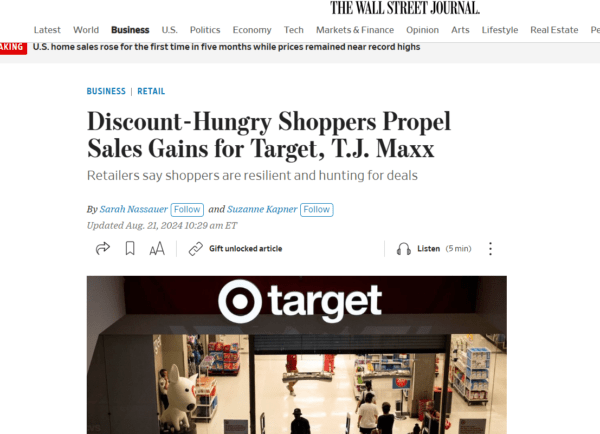
Small business owners often fall into the trap of pricing their products or services too low. They believe this strategy will help them compete with larger companies and attract more customers. However, this approach can be detrimental to their success and growth. Let’s explore why selling at a premium is not just better, but essential for small businesses.
A recent headline in the WSJ writes how shoppers are hungry for deals from Target, TJ Maxx and other retailers. This is great for large, big box brands. However, it’s not good for small business owners.
Related articles: Setting Your Best Price. Here’s A Step by Step Guide.
The Pitfalls of Competing on Price
Many small business owners make the mistake of trying to compete with large corporations on price. They slash their prices, hoping to win customers through sheer affordability. But this strategy overlooks a crucial fact: big brands operate on a scale that most small businesses can’t match.
Large corporations benefit from economies of scale, allowing them to produce goods or services at a lower cost per unit. They can afford to sell at lower prices while still maintaining profitability. Small businesses, lacking this advantage, often find themselves in a race to the bottom, sacrificing profit margins and potentially jeopardizing their financial stability.
The Power of Premium Pricing
Instead of trying to be the cheapest option, small businesses should consider positioning themselves as premium providers. Here’s why:
1. Attracting the Right Customers
Premium pricing helps attract customers who value quality over price. These customers are often more loyal, less price-sensitive, and more likely to become repeat buyers. They recognize the value in your offering and are willing to pay for it.
2. Increased Perceived Value
Higher prices often lead to a perception of higher quality. When you price your products or services at a premium, you’re signaling to potential customers that what you’re offering is superior to cheaper alternatives.
3. Better Profit Margins
Selling at higher prices allows for better profit margins. This extra cushion can be reinvested into the business, used to improve products or services, or saved for future expansion.
4. Resource for Exceptional Service
With higher profit margins, you can afford to provide better customer service, further justifying your premium pricing and enhancing customer satisfaction.
How to Implement a Premium Pricing Strategy
Transitioning to a premium pricing model requires more than just raising prices. Here are some steps to effectively implement this strategy:
1. Focus on Value, Not Price
Shift your marketing message from price to value. Highlight the unique benefits and solutions your product or service provides. Show potential customers why your offering is worth the premium price.
2. Identify Your Unique Selling Proposition (USP)
What sets your business apart from the competition? Is it superior quality, exceptional customer service, or innovative features? Identify your USP and make it the cornerstone of your marketing efforts.
3. Target the Right Market Segment
Not everyone will be willing to pay premium prices. Identify and target the market segments that value quality and are less price-sensitive.
4. Enhance Your Brand Image
A premium price point should be reflected in every aspect of your brand. This includes your website, packaging, customer service, and overall customer experience.
5. Continuously Improve Your Offering
To justify premium pricing, you must continually enhance and improve your products or services. Stay ahead of the curve and always look for ways to add value for your customers.
Case Studies: Success Through Premium Pricing
Let’s look at two hypothetical examples of small businesses that successfully implemented premium pricing strategies:
Artisanal Coffee Roaster
A small coffee roastery was struggling to compete with large chain coffee shops on price. Instead of lowering prices further, they decided to position themselves as a premium brand. They focused on sourcing high-quality, ethically produced beans, perfected their roasting techniques, and created a luxurious in-store experience.
By charging premium prices, they attracted coffee enthusiasts willing to pay more for superior quality and unique flavors. Their profit margins improved, allowing them to invest in better equipment and expand their product line.
Boutique Web Design Agency
A small web design agency was losing projects to cheaper freelancers and large agencies offering cookie-cutter solutions. They decided to pivot to a premium pricing model, focusing on providing highly customized, data-driven websites for specific industries.
By positioning themselves as industry experts and charging premium rates, they attracted clients who valued their specialized knowledge and tailored approach. This allowed them to work on fewer, higher-value projects, improving both their work-life balance and profitability.
Overcoming the Fear of Losing Customers
One of the biggest hurdles in implementing a premium pricing strategy is the fear of losing customers. However, it’s important to remember that not all customers are created equal. By focusing on attracting customers who value quality and are willing to pay for it, you’re likely to build a more stable and profitable customer base.
Moreover, the customers you might lose due to higher prices are often the ones who cause the most headaches – those who are always looking for discounts, are never satisfied, and consume a disproportionate amount of your time and resources.
Conclusion: Embrace Your Worth
As a small business owner, it’s time to stop undervaluing your products or services. Embrace premium pricing as a strategy to attract the right customers, improve your profit margins, and build a sustainable business.
Remember, you’re not just selling a product or service – you’re selling a solution to your customers’ problems. By focusing on the value you provide and targeting customers who appreciate that value, you can build a thriving business that stands out from the competition.
Don’t fall into the trap of competing on price with large corporations. Instead, carve out your niche, highlight your unique value proposition, and confidently charge prices that reflect the true worth of what you offer. Your business – and your bottom line – will thank you for it.
Related articles: You Can’t Save the World by Selling Cheap. Profit Is a Must.












